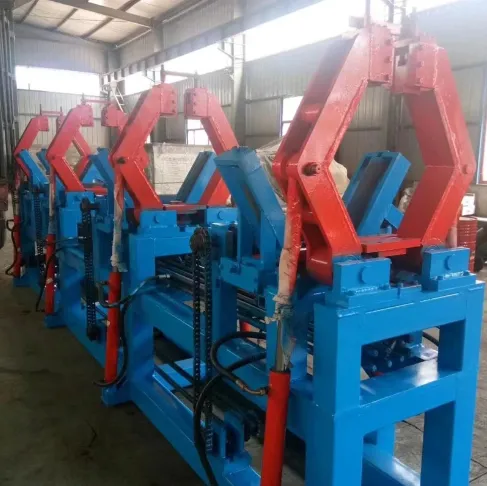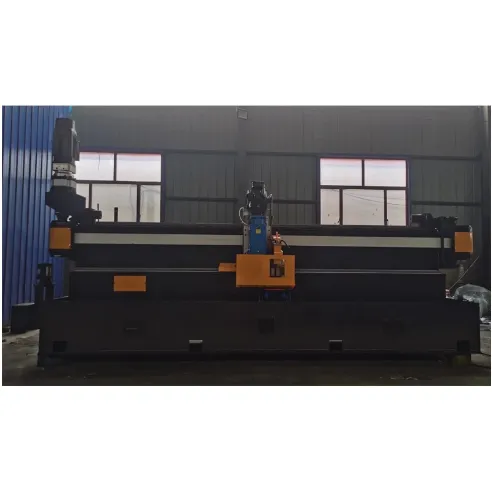Bar Straightening Machine Price High-Precision & Cost-Effective Solutions
- Understanding the Variables Behind Bar Straightening Machine Price
- Technical Advantages Driving Modern Straightening Performance
- Investment Analysis: Calculating Long-Term Operational Value
- Manufacturer Comparison: Capabilities Versus Cost Structures
- Customization Options for Material-Specific Requirements
- Application Case Studies Across Industrial Sectors
- Strategic Considerations Beyond Base Bar Straightening Machine Price

(bar straightening machine price)
Understanding the Variables Behind Bar Straightening Machine Price
Purchasing a bar straightening system involves complex cost considerations beyond the initial invoice. Machine specifications significantly impact pricing - with standard 10-12mm capacity equipment starting around $25,000, while heavy-duty systems capable of processing 40-50mm reinforcement rods can exceed $120,000. Structural differences between basic two-roller models and advanced CNC-controlled units with automatic cutting functions create price variations exceeding 300%. Additional features like hydraulic decoiling systems or touchscreen interfaces typically add 15-22% to the base investment. Material handling capacity remains the primary price driver: systems processing under 3 tons hourly cost approximately 40% less than 8-10 ton/hour production models. Geographical factors also influence final costs, with European manufactured units typically commanding 20-30% premiums over Asian equivalents due to stricter compliance requirements.
Technical Advantages Driving Modern Straightening Performance
Contemporary straightening technology delivers precision tolerances between ±0.2mm/meter through multi-roller architecture featuring 8-12 counter-rotating stations. This evolution has reduced material waste by approximately 17% industry-wide since 2018. Advanced servo-controlled systems adapt roller pressure dynamically based on material sensors, increasing throughput by 22-35% compared to hydraulic equivalents. Integrated laser measurement systems provide real-time diameter verification within 0.1mm accuracy, automatically adjusting straightening parameters to maintain consistency. Such automation minimizes human intervention while increasing output reliability. Modern machines incorporate abrasion-resistant tungsten carbide rollers lasting 3-4 times longer than traditional steel components, reducing long-term operational expenditures despite higher initial bar straightening machine price
points.
Investment Analysis: Calculating Long-Term Operational Value
While equipment cost remains a critical consideration, operational efficiency delivers the true financial impact. Modern straightening systems typically achieve 97-99% material utilization versus manual processing which wastes 8-12% through imprecise cuts and suboptimal straightening. This efficiency differential recoups approximately $18,000 annually per machine when processing standard reinforcement bars at 5 tons/hour. Energy consumption presents another cost variable: servo-electric systems consume 35-40% less power than hydraulic alternatives, saving $2,300-$3,500 yearly in electricity. Downtime reduction through automated processing creates additional value - with modern equipment achieving 92-95% operational availability compared to 78-85% for older models. Maintenance constitutes 8-12% of TCO over five years for well-designed systems versus 15-22% for dated equipment requiring frequent roller replacements and mechanical adjustments.
Manufacturer Comparison: Capabilities Versus Cost Structures
| Manufacturer | Price Range ($) | Max Capacity (mm) | Speed (m/min) | Tolerance | Automation Level |
|---|---|---|---|---|---|
| European Premium Brand | 85,000-250,000 | 8-50 | 120-180 | ±0.15mm/m | Full CNC |
| American Industrial Supplier | 65,000-190,000 | 6-40 | 100-150 | ±0.20mm/m | CNC with options |
| Asian Market Leader | 35,000-120,000 | 5-32 | 90-130 | ±0.25mm/m | Semi-auto |
| Entry-Level Import | 18,000-50,000 | 3-20 | 60-100 | ±0.5mm/m | Manual adjustment |
Manufacturer selection requires balancing precision requirements against budget constraints. European systems provide superior tolerances but demand significant investment, while Asian suppliers offer compelling bar straightening machine price points for operations where absolute precision is secondary to basic functionality. American manufacturers typically position themselves as mid-range solutions with strong after-sales support networks. Equipment lifecycle costs show European machines retaining 45-55% residual value after five years versus 30-35% for entry-level Asian imports, offsetting their higher initial cost during asset rotation cycles.
Customization Options for Material-Specific Requirements
Industrial applications increasingly demand tailored configurations for specialized materials. Processing aerospace-grade titanium alloys requires hardened steel rollers with precise temperature control systems, increasing standard equipment costs by 25-40%. For concrete reinforcement applications, manufacturers add rust-inhibiting spray systems ($7,500-12,000 upgrade) that extend product shelf life on construction sites. High-volume fastener production often integrates secondary operations like chamfering or threading heads, creating integrated systems costing 50-75% more than basic straightening units but eliminating separate processing stages. Anti-vibration foundations for seismic regions or explosion-proof components for hazardous environments constitute other common customizations that affect final bar straightening machine price points.
Application Case Studies Across Industrial Sectors
A reinforcing steel fabricator handling 8,000 tons annually reduced processing time by 37% after installing an automated $185,000 system, achieving full ROI within 19 months. The integrated straightening-cutting solution processed 5.2 tons/hour versus their previous manual operation at 2.3 tons/hour while improving dimensional consistency. Similarly, an automotive components manufacturer eliminated a production bottleneck by implementing a custom-designed $320,000 decoiling-straightening system for suspension components, increasing their press line feed accuracy to ±0.05mm. Construction material suppliers report 12-18% reduction in concrete reinforcement bar waste after upgrading precision straightening equipment. The bar straightening machine price premium typically delivers quantifiable benefits across these varied implementations.
Strategic Considerations Beyond Base Bar Straightening Machine Price
The optimum equipment selection balances functional requirements against lifecycle costs. Technical support accessibility remains crucial - operations in remote locations should prioritize manufacturers offering 48-hour service response guarantees, typically adding 8-12% to service contracts but minimizing costly production interruptions. Future expansion planning warrants consideration; modular designs accommodating later throughput increases (generally 30-50% capacity expansion potential) prove more economical than premature oversized installations. Energy certification analysis reveals that IE4-class motors reduce electricity consumption by 15-18% over standard models, justifying their premium through operational savings within 2-3 years. When evaluating bar straightening machine price structures, forward-thinking operations factor in sustainability metrics including 95% recyclability rates for modern equipment versus 75-80% for older designs, anticipating increasingly stringent environmental regulations.

(bar straightening machine price)
FAQS on bar straightening machine price
Q: What is the price range for bar straightening machines?
A: Prices typically range from $3,000 for basic manual models to over $50,000 for automated industrial systems. Final costs depend on capacity, brand reputation, and customization needs. Request manufacturer quotes for precise bar straightening machine pricing.
Q: How does a steel bar straightening and cutting machine work?
A: The machine feeds coiled rebar through straightening rollers to eliminate bends, then cuts straightened bars to preset lengths via hydraulic blades. This integrated process combines straightening precision (accuracy: ±2mm/m) and cutting functions into one operation. Automation significantly reduces manual labor and material waste.
Q: What industries use bar decoiling and straightening machines?
A: Primary users include construction firms, concrete reinforcement plants, and metal fabrication workshops. These machines process deformed steel bars (rebar) or round bars for structural frameworks, prefab components, and seismic reinforcements. Decoiling-straightening systems optimize space by eliminating manual coil handling.
Q: What factors affect bar straightening machine price most?
A: Key cost drivers are processing capacity (e.g., 6-40mm diameter range), automation level (manual vs PLC-controlled), and motor power (3-15HP). Additional features like servo cutting or CNC precision increase prices by 20-40%. Shipping and customs duties also impact final investment for imported units.
Q: Why choose a combined decoiling-straightening machine over separate units?
A: Integrated systems save 30-50% floor space and reduce transfer time between processes. They maintain consistent tension during decoiling to prevent new bends after straightening. This all-in-one solution also lowers maintenance costs and operator training requirements compared to standalone equipment.
-
Welded Pipe Production Line - BzZhou Xinghua Machinery Equipment Manufacturing Co., LTD.|High-Frequency Straight Seam Welding&Precision EngineeringNewsJul.22,2025
-
Welded Pipe Production Line - BzZhou Xinghua Machinery|High-Efficiency, Precision EngineeringNewsJul.21,2025
-
Welded Pipe Production Line-BzZhou Xinghua Machinery Equipment Manufacturing Co.,LTD.|High Precision, Efficient ProductionNewsJul.21,2025
-
Welded Pipe Production Line-BzZhou Xinghua Machinery Equipment Manufacturing Co.,LTD.|High Precision, Efficient ProductionNewsJul.21,2025
-
Welded Pipe Production Line-BzZhou Xinghua Machinery Equipment Manufacturing Co.,LTD.|High Precision, Efficient ProductionNewsJul.21,2025
-
Welded Pipe Production Line-BzZhou Xinghua|High Efficiency&CustomizationNewsJul.21,2025


